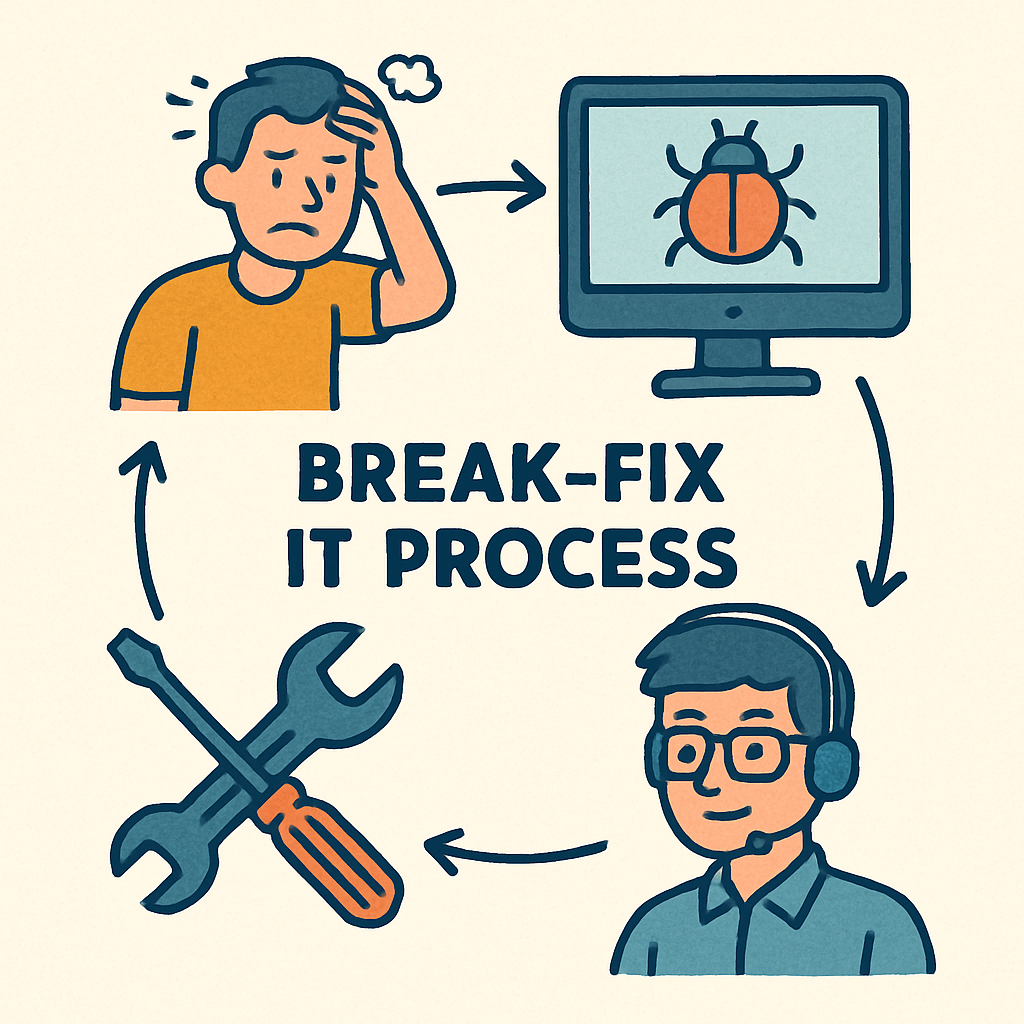Hidden Costs of Break-Fix IT: Unveiled Secrets

Understanding the Hidden Costs of Break-Fix IT
Break-fix IT strategies might seem cost-effective at first glance. You pay only when something breaks.
But this approach can lead to hidden costs. These costs often outweigh the initial savings.
Unpredictable IT service costs can strain budgets. Downtime can disrupt operations and hurt revenue.
Security risks and data loss are real threats. Without proactive management, these issues can escalate quickly.
Understanding these hidden costs is crucial. It helps businesses make informed decisions about their IT strategies.
What Is Break-Fix IT? A Quick Overview
Break-fix IT is a service model based on paying for repairs. Businesses engage IT professionals only when issues arise.
This strategy involves no regular maintenance or monitoring. It relies entirely on fixing problems after they occur.
Here’s how it typically works:
- An IT problem surfaces.
- The business contacts an IT provider.
- The provider repairs the issue, billing for time and materials.
Due to its simplicity, break-fix seems appealing to some companies.
Why Businesses Choose Break-Fix IT
Many businesses are attracted by the pay-as-you-go model of break-fix IT. They pay only for the services they use when they need them.
This model avoids ongoing contracts and monthly fees, which can appeal to tight budgets. Companies believe they will save money by avoiding upfront expenses.
Here are the main reasons businesses choose break-fix IT:
- Immediate cost-effectiveness
- Simplicity and straightforward billing
- Flexibility without long-term commitments
This approach seems economical at first glance, but there are often hidden costs.
The Illusion of Cost Savings: What You Really Pay For
The break-fix IT model gives a false sense of savings. While it seems cheaper at first, hidden costs pile up. Many overlook these until they hit hard.
Unexpected issues can cause massive financial hits. You pay for urgent repairs, often at premium rates. Emergency fixes strain budgets more than planned maintenance.
Here’s what businesses often end up paying:
- High hourly rates for emergency fixes
- Costs of outdated infrastructure
- Financial impact of frequent downtime
Break-fix IT can also mean outdated systems and technologies. Without regular updates, efficiency drops, and costs rise. Overall, this model lacks the strategic planning needed for long-term savings.
The Hidden Costs of Break-Fix IT Strategies
Break-fix IT strategies entice with their simplicity. Yet, the hidden costs often outweigh upfront savings. Many businesses fail to grasp these until it’s too late.
For starters, IT service costs become unpredictable. This poses a challenge for budgeting and financial planning. Sudden expenses disrupt cash flow, making planning difficult.
Consider these hidden costs that might arise:
- Downtime impacts revenue
- Delays in fixing issues strain operations
- Accumulating small failures lead to big expenses
Downtime and lost productivity surface as severe issues. When systems crash, work halts. This results in lost opportunities and dissatisfied customers.
Over time, maintenance expenses rise due to deferred upkeep. Ignoring regular checks can amplify problems, leading to costlier repairs down the line.
Increased security risks and potential data loss pose another threat. Without proactive monitoring, vulnerabilities go unchecked, inviting breaches.
Strategic IT planning becomes scarce in break-fix environments. Long-term IT goals are overlooked, hampering scalability. Businesses find themselves unprepared for growth.
Break-fix IT can make companies reactive rather than proactive. A reactive approach stifles innovation and progress.
Managed IT services offer solutions. By adopting strategic plans, businesses can mitigate these hidden costs.

1. Unpredictable IT Service Costs
With break-fix IT, service costs can be erratic. Unexpected problems lead to unplanned expenses. Businesses often pay more during emergencies.
The lack of consistent billing makes it tough to predict IT budgets. Hence, financial planning is hindered. Companies struggle to anticipate these costs.
Common unpredictable costs include:
- Emergency repair fees
- Premium charges for urgent calls
- Overheads from obsolete systems
These unpredictable costs often go unnoticed initially. But over time, they burden the budget significantly.
2. Downtime and Lost Productivity
Downtime can cripple productivity. Break-fix IT means waiting until something breaks before resolving issues. This leads to unnecessary halts in operations.
When systems fail, employees sit idle. Customer service suffers from unresolved outages, affecting satisfaction and loyalty.
Consider these impacts of downtime:
- Halted operations causing delays
- Lost sales and productivity
- Reduced customer satisfaction

Each downtime instance chips away at revenue. The hidden costs of lost productivity are substantial.
3. Increased Maintenance Expenses Over Time
Relying on break-fix IT can ramp up maintenance expenses over time. Deferred maintenance escalates repair costs. Small issues grow into larger problems.
Without regular updates, systems age rapidly. This results in more frequent and costly repairs. A reactive approach costs more in the long run.
Common maintenance expenses include:
- Costs of deferred system updates
- Repairing outdated infrastructure
- Increased labor for urgent fixes
Overlooking regular upkeep only inflates long-term maintenance bills.
4. Security Risks and Data Loss
Security risks increase with a break-fix model. Lack of regular updates leaves systems exposed. This can lead to catastrophic data breaches and loss.
When IT issues are dealt with late, vulnerabilities linger. Attackers exploit these gaps, causing severe damage. Data loss occurs when breaches remain unchecked.
Consider these hidden security costs:
- Damage from security breaches
- Losses from data theft
- Costs for recovery and fines

Reacting post-damage is costly and damaging to reputation.
5. Lack of Strategic IT Planning and Scalability
Break-fix IT strategies lack planning. The focus stays on immediate fixes. As a result, strategic IT development takes a backseat.
Without planning, scaling becomes challenging. Business growth demands agile IT systems. Break-fix approaches fail to support this need. The absence of a vision for IT can stifle growth.
Key shortcomings include:
- No long-term IT goals
- Inflexible systems
- Inability to adapt to growth
In the end, lack of planning deters progress and scalability.
Comparing Break-Fix IT to Managed IT Services
Break-fix IT solutions address issues only when they appear. This reactive method can lead to mounting costs and disruptions. Managed IT services, meanwhile, offer proactive management. They focus on preventing problems before they disrupt operations.
The benefit of managed services includes continuous monitoring and updates. Businesses gain insights through regular audits and assessments, promoting a healthier IT environment.
Here’s what managed services offer:
- Proactive problem prevention
- Regular updates and system monitoring
- Structured IT planning and consultation
Contrast this with break-fix:
- Unpredictable repair times
- Greater risk exposure due to delayed fixes
- Lack of ongoing IT strategy
Managed services provide cohesive support and peace of mind. They ensure your business stays ahead of IT challenges.
The Benefits of Proactive IT Management
Proactive IT management shifts focus from reaction to prevention. This approach involves anticipating IT needs and addressing them in advance. It reduces downtime and enhances IT performance.
Businesses experience fewer disruptions and a higher return on investment. Proactive measures include continuous monitoring and strategic updates, tailoring solutions to specific needs.
Key benefits of proactive management:
- Reduced system outages
- Improved overall efficiency
- Predictable IT infrastructure growth
Proactive strategies help businesses stay competitive by optimizing resources.
Cost Predictability and Budget Control
Managed IT services offer predictable costs and better budget control. Unlike break-fix models, they feature fixed monthly expenses. This consistency aids financial planning and reduces unforeseen expenditures.
Businesses can forecast IT budgets with clarity. Managed services minimize emergency spending, allowing funds to be directed elsewhere.
Consider the financial advantages:
- Fixed pricing models
- Reduced emergency repair costs
- Comprehensive service contracts

These cost-effective measures allow companies to allocate resources strategically.
Enhanced Security and Compliance
Managed IT services boost security and ensure compliance with industry regulations. Regular updates and active monitoring mitigate risks. Security breaches are minimized through vigilant oversight.
Businesses comply with regulatory standards and protect sensitive information. Continuous security audits help identify vulnerabilities, maintaining a robust defense against cyber threats.
Security and compliance benefits include:
- Regular vulnerability assessments
- Adherence to compliance standards
- Enhanced data protection
A proactive security stance safeguards company reputation and client trust.
Improved Business Agility and Innovation
Managed IT fosters business agility and drives innovation. By aligning IT with business objectives, companies adapt quickly to market changes. This flexibility enables faster response times to emerging trends.
Furthermore, managed IT solutions encourage innovation. Access to the latest technology and expert advice keeps businesses at the forefront. Companies can experiment with new tools without risking service disruptions.
Advantages of agility and innovation:
- Swift adaptation to change
- Access to cutting-edge technology
- Encouragement of creative solutions
Managed IT services empower businesses to thrive in a dynamic environment.
Making the Switch: Transitioning from Break-Fix to Managed IT
Shifting from break-fix to managed IT involves several strategic steps. Begin by assessing your current IT landscape. Identify gaps and potential areas for improvement. This comprehensive evaluation aids in tailoring managed solutions to your needs.
Next, choose a reputable managed service provider with a proven track record. Align their services with your business goals to ensure a seamless transition.
Key considerations during the switch:
- Evaluate existing IT infrastructure
- Select a trusted managed service provider
- Align IT solutions with business strategy

This transition not only reduces IT headaches but also enhances your business’s efficiency and scalability.
Conclusion: The True Value of Proactive IT Support
The hidden costs of break-fix IT strategies can be a significant burden. Unpredictable expenses and potential downtime impact business productivity. By contrast, proactive IT support offers tangible benefits.
Managed services provide a steady hand in guiding IT operations. They ensure better cost control, improved security, and enhanced reliability. This proactive approach aligns IT goals with business objectives.
Ultimately, embracing proactive IT solutions fosters growth. This strategic alignment positions businesses for future success and digital transformation.
Key Takeaways
- Break-fix IT strategies seem cost-effective but often lead to hidden costs that outweigh initial savings.
- Unpredictable IT service costs, downtime, and security risks emerge from break-fix models, complicating budget management.
- Businesses may face high emergency repair rates, lost productivity, and outdated infrastructure over time.
- Switching to managed IT services provides proactive support, predictable costs, and improved security, enhancing overall efficiency.
- Embracing proactive IT support aligns technology with business goals, fostering growth and digital transformation.


